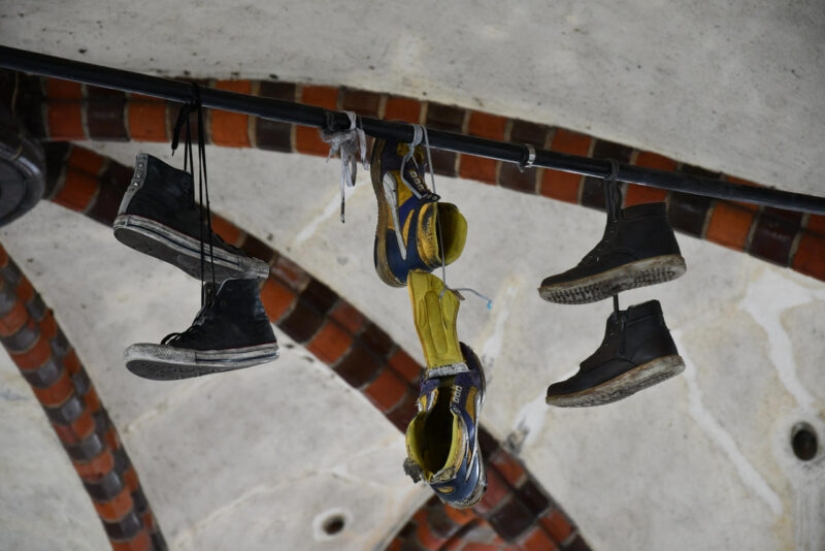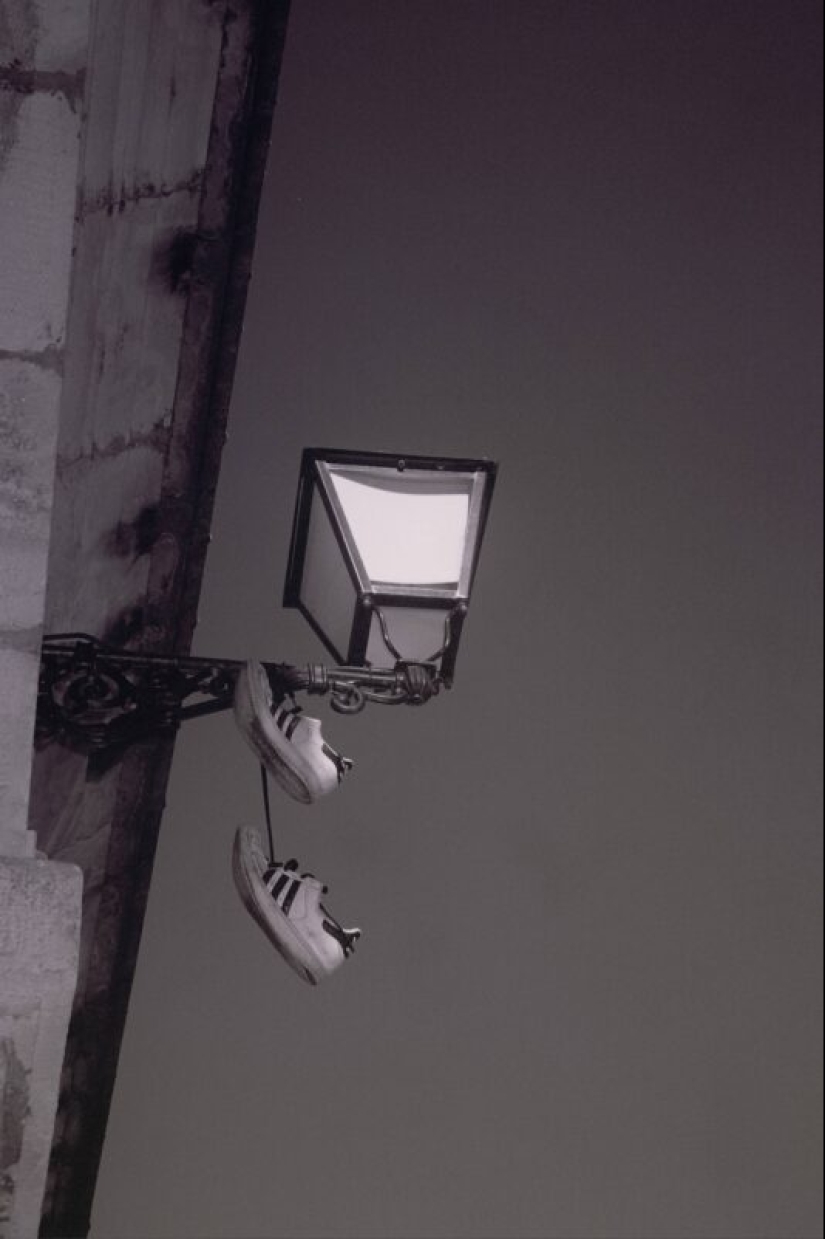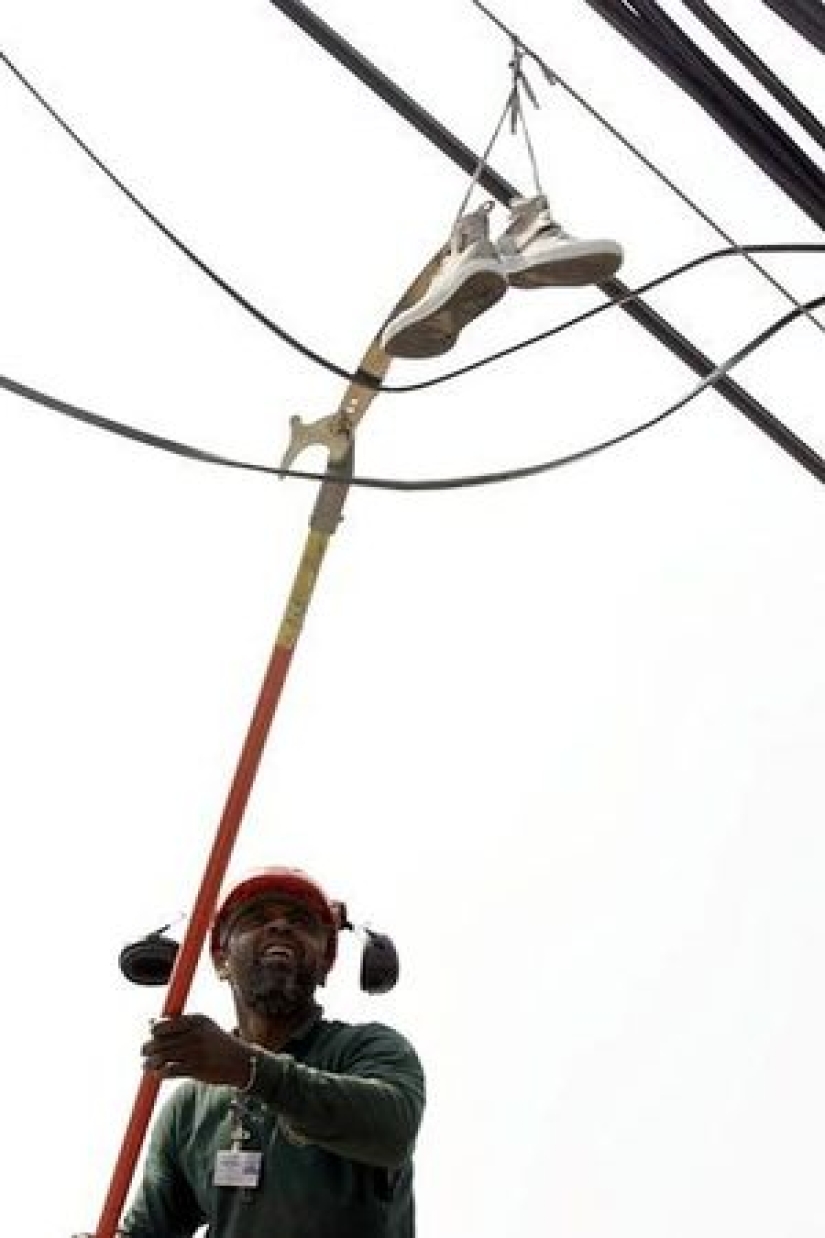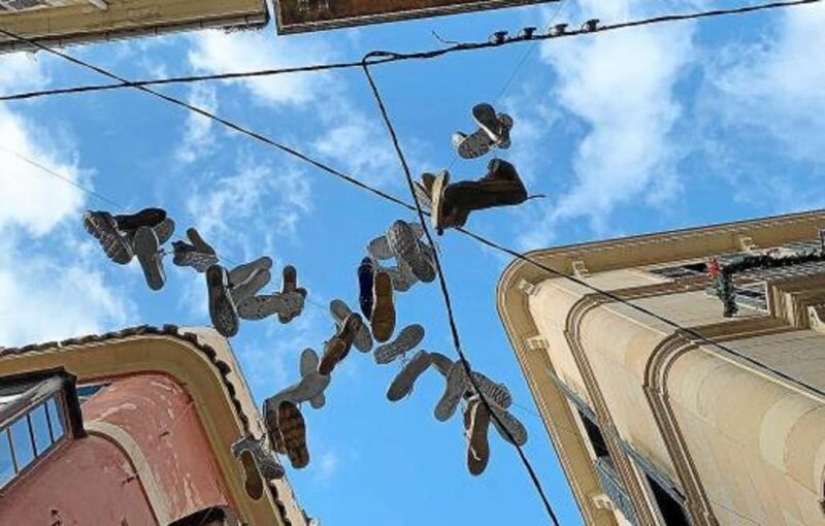6 theories explaining the strange custom of hanging shoes on wires
By Pictolic https://pictolic.com/article/6-theories-explaining-the-strange-custom-of-hanging-shoes-on-wires.htmlEach of us saw sneakers or shoes hanging over the street on wires. This phenomenon can be called international-it is found in our cities and villages, in Asia and Africa, and in the United States even got its own name-shoefiti (shufiti) – from the words " shoe "(shoes) and" graffiti " (graffiti). There are many versions about who makes such "installations" and why, and we want to tell you about the most popular ones.


In the West, many believe that shoes suspended from wires are used by criminal groups as a sign of the delimitation of territories of influence. And there is also an opinion that in this way drug sellers send a signal to their customers or colleagues.
This version is supported by the fact that shufiti is found mainly in the disadvantaged areas of large cities. On the other hand, it's hard to imagine a Wall Street clerk throwing shoes on wires in front of his own office. And for our realities, this version is not suitable, because in the cities of the CIS, such "decoration" is more often found in residential areas, and not in ghettos.

Basically, young people are engaged in throwing sneakers on the wires, so the version that this is a good old custom of students has a right to exist. Someone believes that this way the cheerful student fraternity marks the passing of the session and the beginning of the holidays.
There are other "youth" hypotheses, among which it is worth noting the creation of shufiti in honor of the loss of virginity, the victory of a favorite sports team, or at the place of a person's death, as a tribute to his memory from his closest friends. Sometimes you can hear that demobel have fun like this, but it's unlikely, because army boots on wires are very rare.

In the United States, they believe that sports shoes on wires are the tricks of street basketball teams. It is known that basketball players do not feed bread, just let them throw something, preferably away and higher. They say that this is how they get rid of old gaming sneakers, so that they attract good luck to the former owner. Sports shoes can also serve as a sign that there is a basketball court nearby, which has specific owners.

In Tim Burton's tragicomedy Big Fish (2003), villagers threw their shoes on wires to show that they were not going to leave their native places. You can see the custom in some other pictures of American and European filmmakers, where there is a theme of saying goodbye to their native places. There is also shufiti in the Simpsons series.
Because of this, it is believed that the custom of shufiti has the same roots as throwing coins into a pond. A man, throwing his pair of shoes higher, gives the world a sign that he will definitely return to these places. True or not, bunches of shoes and sneakers over your head can be found in many tourist cities.

If you are lucky enough to live or regularly visit areas with shufiti, then you probably noticed that shoes can hang like this for a very long time, sometimes up to 10 years. Hence the belief that the authors of such compositions are just pretentious cranks who decided to leave a memory of themselves in this way.

In strong winds, nearby wires may come into contact, causing short circuits. Where it is not possible to put the air lines in order, they try to separate them with improvised means. Sometimes a brick tied to a rope with a hook is used for this purpose, but it is much easier to tie two old shoes with laces and throw them over the problematic wire.
All these versions may be relevant, and in different places on the planet. they also sinned by hanging shoes on overhead transmission lines, so this custom is not borrowed by us in the West. Our grandparents could already contemplate the Soviet shufiti on the wires of our cities and villages in the 50s and 60s, and this was hardly due to one of the reasons described above.

Someone may remember throwing someone else's shoes on the wires in pioneer camps or at school, just as a joke or as a kind of bullying. Surely there are also those who did it out of mischief, or to annoy adults or surprise friends.
It must be said that shufiti is made not only on wires. Sometimes compositions of shoes adorn fences, architectural monuments and just trees. In the state of Nevada, a huge poplar tree grew by the road, which was thrown with shoes" for luck " since the mid-1980s. This landmark of local significance no longer exists – in 2010, someone cut down a "sneaker" tree for an unknown purpose.
About such a phenomenon as shufiti even write scientific papers. A historian was writing a dissertation on the connection of suspended shoes to the Holocaust, drawing an analogy with the Nazi order to store the shoes of their victims. By the way, this scientific work was declared invalid.

Strangely, shufiti is also useful to some people. Electric companies and utilities are forced to pay low-skilled workers to take their shoes off the wires. That is, these sneakers give someone the opportunity to earn a piece of bread.
Finally, it should be clarified that shufiti is not considered an offense yet, because in no country in the world is there a law prohibiting throwing shoes on wires. But there is one "but": hanging foreign objects to power lines or communications, you can get suspicion of trying to damage someone's property or disrupt communications for a criminal purpose.

And in the United States, lawmakers are seriously considering banning shufiti because of the possible connection of this phenomenon with the criminal world. It is not known whether such a law will be adopted or not-it has been under consideration for several years. Most likely, congressmen have more important questions than someone's torn sneakers hanging over their heads.
And what do you think about this unusual tradition?
Keywords: Culture | Shoes | Graffiti | Youth | Tradition | Society | Custom | Sneakers | Wire
Post News ArticleRecent articles

We present you a selection of amazing beaches — but today these are not standard holiday destinations, but really unusual places. ...

Aerial photographer cronista johnny Miller demonstrate dramatically the gap between rich and poor in cities of South Africa, Mexico ...
Related articles

All the things that surround us were once invented and changed over time, becoming more functional, safe and aesthetic. Any, even ...

The term "photography" appeared at the beginning of the XIX century, but the history of this art form has its roots in much more ...

The project of the artist Valery Barykin "Soviet pin-up" is, first of all, retro, not burdened with criticism of the regime or ...

On April 22, 1923, Bettie Page was born in Nashville, who became a sex symbol throughout the country in the middle of the century. ...